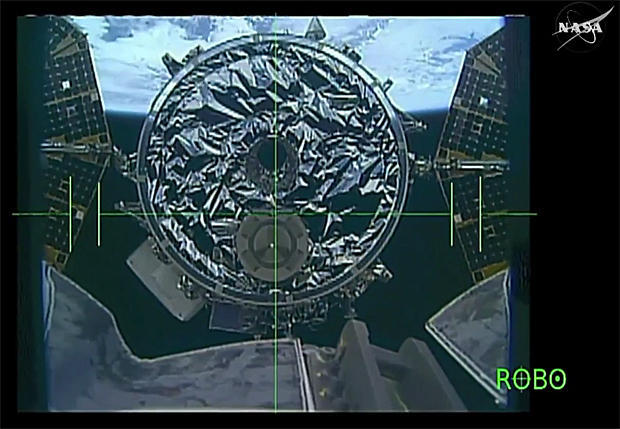Cygnus cargo ship attached to space station
An Orbital ATK Cygnus cargo ship loaded with 5,100 pounds of needed equipment and supplies was grappled by the International Space Station’s robot arm Sunday and pulled in for berthing.
Six days after launch, the unpiloted spacecraft pulled up to within about 39 feet of the lab complex and then stood by while Japanese astronaut Takuya Onishi and NASA crewmate Kate Rubins, operating the robot arm, locked onto a grapple fixture at 7:28 a.m. EDT (GMT-4).
“Cygnus capture is complete,” Onishi radioed. “What a beautiful vehicle. Congratulations to the Orbital ATK team and the teams in Houston and (Japan) on the successful arrival of Cygnus 5 to the International Space Station. And thank you very much for bringing tons of science and supplies to the station.
“We copy, and congratulations to the on-board crew,” replied Rebecca Wingfield from the Johnson Space Center in Houston. “You guys made it look really easy. Great job.”
Flight controllers took over arm operations at that point, remotely pulling the Cygnus in for berthing at the Earth-facing port of the station’s central Unity module. Motorized bolts in the common berthing mechanism then drove home, locking the spacecraft in place about three-and-a-half hours after capture.
The Cygnus was launched from Wallops Island, Va., last Monday atop an upgraded Orbital ATK Antares rocket. It was the first flight of an Antares since a spectacular explosion seconds after liftoff in October 2014 that destroyed another station-bound cargo ship.
Equipped with newer, more powerful Russian engines, the Antares 230 chalked up a flawless climb to space in its return to flight, releasing the Cygnus spacecraft about nine minutes after launch.
The original flight plan called for a two-day rendezvous with the station. But after a one-day launch delay, mission managers opted to stretch out the rendezvous to make way for the launch last Wednesday of a Russian ferry craft carrying three fresh crew members to the station: Soyuz MS-02 commander Sergey Ryzhikov, flight engineer Andrey Borisenko and NASA astronaut Shane Kimbrough.
The Soyuz docked at the station’s upper Poisk module early Friday, clearing the way for the Cygnus arrival and berthing.
The cargo ship is loaded with some 5,100 pounds of supplies and equipment, including nearly 1,100 pounds of research gear, 1,290 pounds of crew supplies, including clothing and food, 2,255 pounds of space station hardware, new laptop computers, spacewalk equipment and about 92 pounds of Russian hardware.
Over the next three-and-a-half weeks, the station crew will unload the Cygnus and re-pack it with trash and no-longer-needed equipment.
In the meantime, Rubins, Onishi and cosmonaut Anatoly Ivanishin will ready their Soyuz MS-01 ferry ship for return to Earth. If all goes well, the trio will undock from the station’s Rassvet module at 8:37 p.m. next Saturday night, landing on the steppe of Kazakhstan a few seconds before midnight U.S. time to close out a 115-day stay in space.
Kimbrough and his crewmates will have the station to themselves until mid November when the Soyuz MS-03 spacecraft arrives bringing vehicle commander Oleg Novitskiy, European Space Agency astronaut Thomas Pesquet and NASA veteran Peggy Whitson to the outpost. They are currently due to arrive two days before the Cygnus cargo ship is unberthed and released on Nov. 18.
Before the Cygnus plunges back into the atmosphere and burns up, researchers will activate an experiment inside the cargo ship, igniting a small fire in a vented enclosure to learn more about how flame propagates in weightlessness. Video and data will be downlinked before the cargo ship re-enters the atmosphere Nov. 26.

